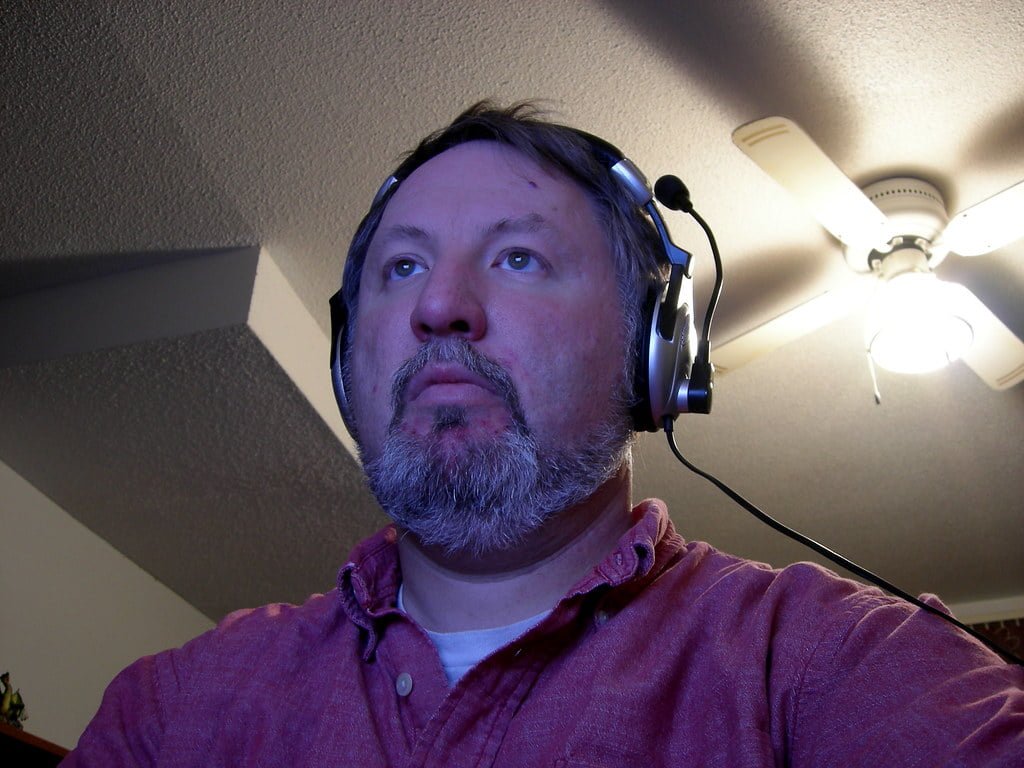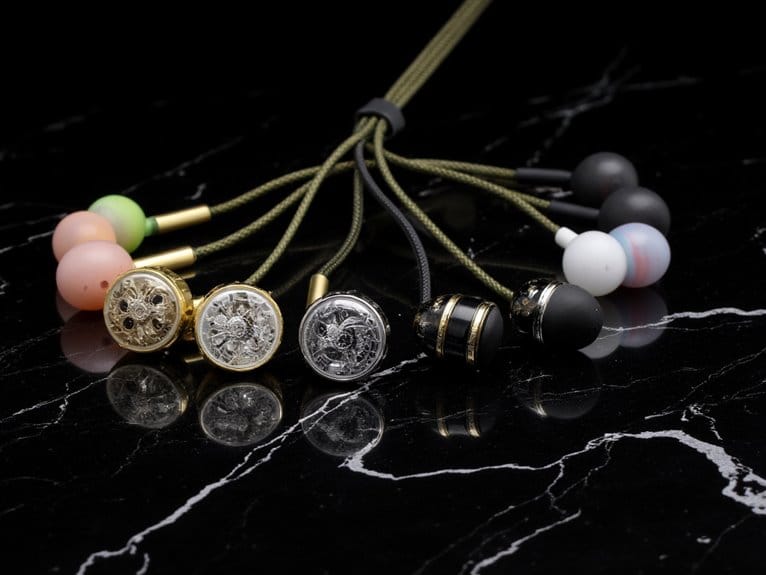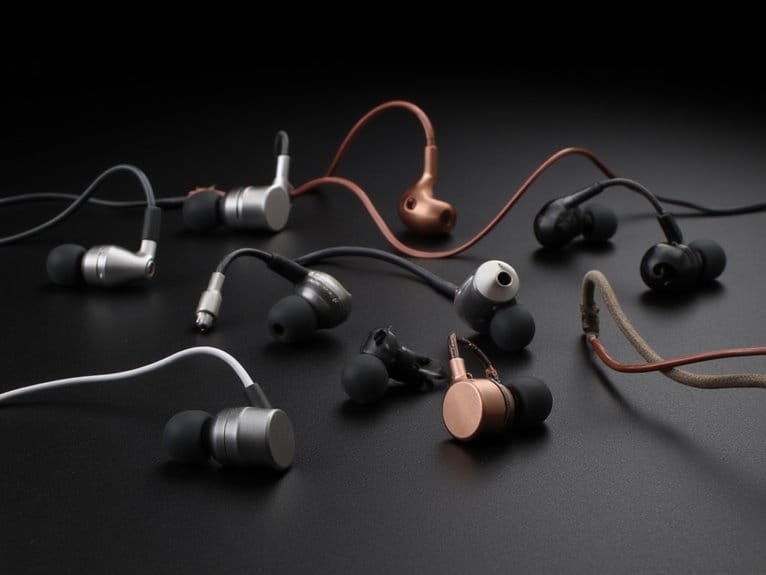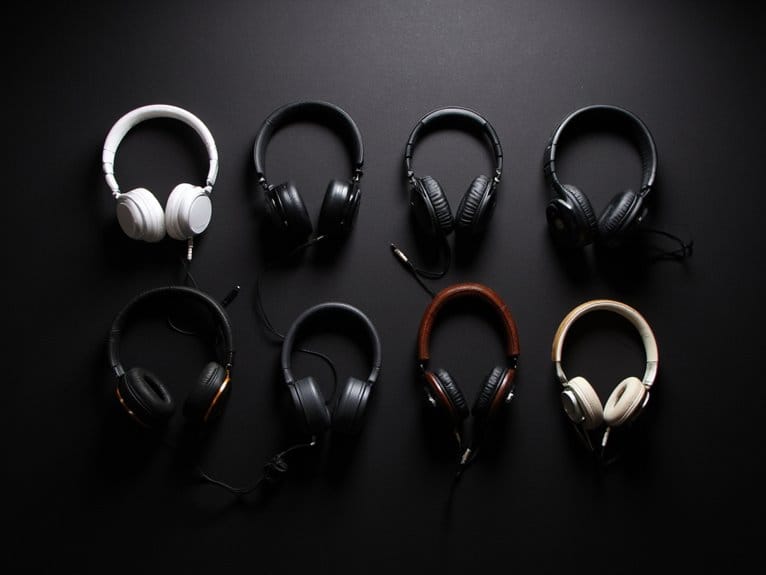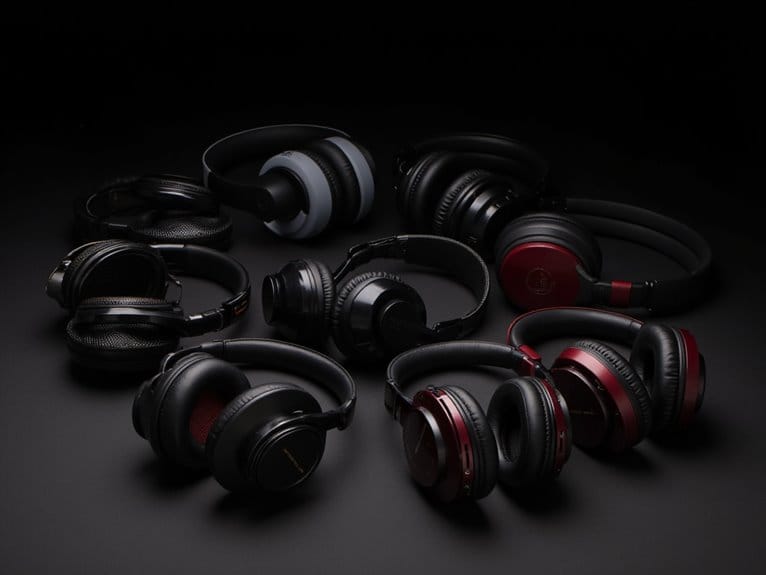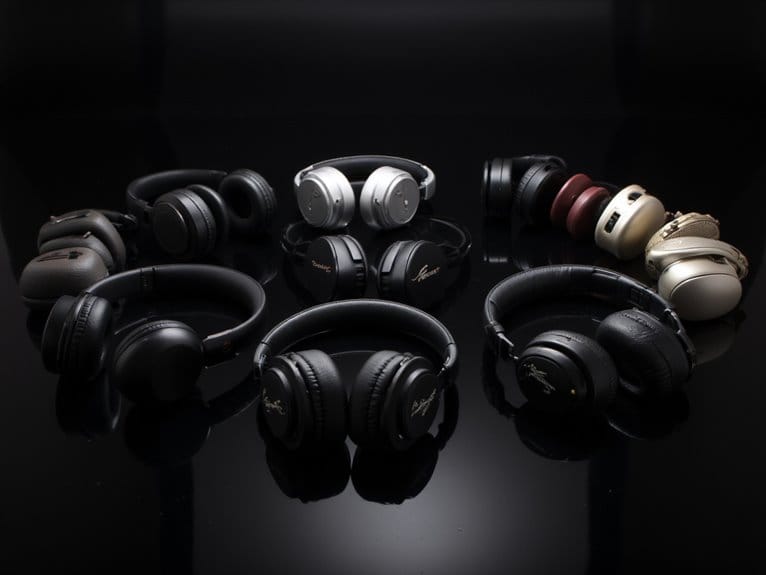How to Choose Headphones for Mixing and Tracking
When choosing headphones for mixing and tracking, pay attention to the type, frequency response, comfort, and durability. Opt for closed-back headphones for tracking in noisy environments, while open-back ones are great for critical listening and mixing tasks. Consider impedance and sensitivity to guarantee accurate audio reproduction, with low-impedance headphones being easily driven and high-impedance ones potentially needing amplifiers. Comfort features like adjustable headbands, padded ear cups, and lightweight materials are vital for long sessions. Brands like Sennheiser, Beyerdynamic, Audio-Technica, Sony, and AKG offer top options for accurate sound reproduction and detailed sound quality. Prioritizing these factors is essential for achieving the desired sound quality in studio tasks.
We are supported by our audience. When you purchase through links on our site, we may earn an affiliate commission, at no extra cost for you. Learn more.
Factors to Consider When Choosing
When selecting headphones for mixing and tracking, it is important to carefully consider various factors to guarantee top performance and accuracy in sound reproduction. Studio headphones play a significant role in the quality of your audio production. One of the primary aspects is the headphone type. Whether you choose closed-back, open-back, or semi-open headphones depends on your specific needs for mixing or tracking. Closed-back headphones provide isolation, ideal for tracking where bleed can be an issue. Open-back headphones, on the other hand, offer a more natural sound but may not isolate external noise well. Semi-open headphones aim to strike a balance between the two.
Furthermore, a flat frequency response is essential for accurate sound reproduction and balanced tonal quality. This ensures that what you hear is a faithful representation of the recorded audio. Comfort is also important, especially during long studio sessions. Look for headphones with ample padding and adjustable headbands to prevent fatigue. Durability is another key aspect to take into account. Investing in sturdy headphones that can withstand regular use is essential for long-term satisfaction.
Top brands like Sennheiser, Beyerdynamic, Audio-Technica, Sony, and AKG are renowned for their performance in mixing and tracking applications. Choosing headphones from reputable brands can often guarantee a certain level of quality and reliability in your audio work.
Types of Headphones for Tracking
When selecting headphones for tracking, it’s vital to think about the distinctions between closed-back and open-back designs in relation to sound leakage and isolation. Moreover, comprehending the effects of impedance and sensitivity on tracking quality is necessary for precise monitoring during recording sessions. Choosing the appropriate type of headphones based on these factors will greatly influence the overall tracking experience in a studio environment.
Closed-Back Vs Open-Back
In selecting headphones for tracking purposes, the differentiation between closed-back and open-back designs plays a pivotal role in determining the best choice for a particular recording environment.
- Closed-back headphones:
- Provide better sound isolation.
- Ideal for tracking in noisy environments.
- Prevent sound leakage into microphones during recording sessions.
- Open-back headphones:
- Offer a more natural sound with a wider soundstage.
- Great for mixing due to accurate audio representation.
- Suitable for critical listening.
The decision between closed-back and open-back headphones hinges on specific needs, with each type offering distinct advantages tailored to tracking or mixing requirements.
Impedance and Sensitivity
To optimize headphone selection for tracking purposes, understanding the relationship between impedance and sensitivity is essential. Impedance in headphones affects the voltage required for best performance, where high-impedance headphones demand more power. On the other hand, sensitivity indicates how efficiently headphones convert electrical signals into sound, with higher sensitivity resulting in louder volume levels for a given input power, typically measured in decibels per milliwatt. Low-impedance headphones are more easily driven and suitable for portable devices, while high-impedance headphones may necessitate a dedicated headphone amplifier to reach their full potential. These factors play a vital role in choosing the right headphones for tracking in a studio setting, ensuring accurate audio reproduction and monitoring during recording sessions.
Importance of Frequency Response and Isolation
Understanding the importance of frequency response and isolation is fundamental when selecting headphones for mixing and tracking tasks in a studio environment.
- Frequency Response: The headphones’ frequency response determines how well they reproduce different audio frequencies. A balanced frequency response is essential for accurate sound representation during mixing and tracking sessions in the studio.
- Isolation: Isolation in headphones is crucial to prevent external sounds from interfering with the audio being monitored. Closed-back headphones are preferred for tracking as they offer better isolation, while open-back headphones provide a more natural sound ideal for mixing purposes.
In the studio environment, having headphones with a precise frequency response is important for accurately capturing all audio frequencies present in the mix. Additionally, proper isolation ensures that external noises do not compromise the quality of the audio being monitored. Selecting the right type of headphones, whether closed-back for tracking or open-back for mixing, plays a significant role in achieving the desired sound quality during both mixing and tracking tasks.
Impedance and Sensitivity Considerations
When selecting headphones for mixing and tracking in a studio environment, considering impedance and sensitivity levels is vital for peak performance and compatibility with audio equipment. Impedance, measured in ohms, plays a significant role in determining how much power headphones require to operate efficiently. Headphones with higher impedance levels demand more power to be properly driven, while those with lower impedance levels are more easily powered. On the other hand, sensitivity, indicated in dB/mW, defines how loud headphones can get with a specific amount of power. Headphones with higher sensitivity levels are more efficient, requiring less power to achieve the same volume as headphones with lower sensitivity. Understanding the relationship between impedance and sensitivity is crucial in selecting headphones that not only work well with your audio equipment but also meet your tracking and mixing needs effectively. By choosing headphones with the right balance of impedance and sensitivity, you can guarantee performance and accurate audio representation during your studio sessions.
Comfort and Durability for Long Sessions
Guaranteeing excellent comfort and durability is vital for extended studio sessions, necessitating thoughtful considerations in headphone selection. When choosing headphones for mixing and tracking, comfort and durability play a significant role in preventing discomfort and fatigue during long hours of use. Here are some key factors to take into account:
- Adjustable headbands: Opt for headphones with adaptable headbands to personalize the fit according to your head size, ensuring a comfortable and secure feel.
- Padded ear cups: Look for headphones with luxurious padded ear cups to provide a soft and comfortable seal around your ears, reducing pressure points and enhancing comfort for extended wear.
- Lightweight materials: Select headphones made from light materials to minimize the overall weight on your head, preventing strain and fatigue during prolonged studio sessions.
- Breathable padding and moisture-resistant materials: Choose headphones with breathable padding and moisture-resistant materials to keep your ears cool and dry, allowing for extended use without discomfort.
Furthermore, sturdy construction is essential to ensure the longevity and reliability of your headphones, making them a worthwhile investment for your studio setup. By prioritizing comfort and durability features such as adjustable headbands, padded ear cups, lightweight materials, breathable padding, and moisture-resistant materials, you can enhance your studio experience and minimize fatigue during long mixing and tracking sessions.
Top Brands for Mixing and Tracking
In the domain of audio engineering, the selection of headphones for mixing and tracking is greatly influenced by the reputation and quality offered by top brands in the industry. When it comes to studio headphones, several brands stand out for their exceptional performance in mixing and tracking applications. Sennheiser’s HD series, including models like the HD 600 and HD 650, are renowned for their accurate sound reproduction, making them a popular choice among audio professionals.
Beyerdynamic is another top brand known for its high-quality studio headphones. The DT 770 Pro and DT 990 Pro models are favored for their comfort and detailed sound quality, providing an excellent listening experience for long mixing and tracking sessions. Audio-Technica also offers excellent options for audio engineers, with the ATH-M50x and ATH-R70x headphones delivering a balanced sound signature that is ideal for critical listening tasks.
Sony is a trusted name in the audio industry, with headphones like the MDR-7506 and MDR-Z1R known for their durability and clear audio performance. For those seeking headphones with a spacious soundstage and accurate imaging, AKG’s K702 and K712 Pro models are popular choices, perfectly suited for mixing and tracking tasks. When it comes to selecting top brands for mixing and tracking, these options provide a range of features to meet the needs of audio professionals.

